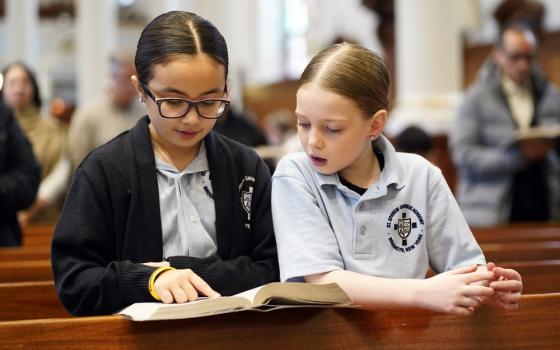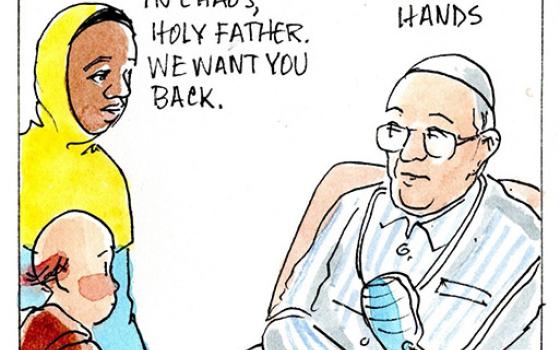James Carroll was given ample space in the Boston Globe to explain his thoughts on the Second Vatican Council. And, fine writer that he is, he recalls with exquisite detail his entry into seminary in the early 1960s. He remembers what he was wearing, he remembers the changes in his routine, he remembers his surprise when a television was brought into the common room of the seminary so that the inmates could watch the opening of the Second Vatican Council.
Then, Carroll clarifies his hermeneutic when he writes of the speech Pope John XXIII delivered on that opening day of the Council in 1962, “The speech was in Latin, and the revolution was still hidden from us. But that day changed everything.” Changed everything? This is the most succinct statement of the hermeneutic of rupture I have yet seen. And, while I value the succinct in certain instances, it is not always of much value to the historian.
Pope John XXIII’s speech did not, in fact, “change everything.” Well, let me qualify that remark. Clearly, the speech, and the Council it inaugurated, changed everything for Mr. Carroll, and that is what matters most to Carroll – this essay, and others he has penned like it, are nothing if not self-referential. For him, the Council unleashed the promise of reforms Carroll desired. For him, the Council, opened a new day, in which all was possible. For him, the Council cast aside centuries of foolish encrustations of the faith, allowing 20th century Catholics like himself to look past the Church and discern the figure of Jesus Christ Himself. And – lo and behold – Jesus turns out to look a lot like an urbane, late twentieth century, New York Times-reading, Bostonian liberal. Who knew?
Take this example of the changes wrought by Vatican II, as Carroll remembers them:
We seminarians fathomed the depth of change by measuring it in ourselves. Having seen, for example, where the ‘Christ-killer’ charge against the Jews had led, the Vatican II fathers firmly rejected it. But in Scripture class we still read Gospels that demonized Jews. So, taking our cue from the Vatican II fathers, we radically changed how we read the sacred texts, abandoning literalism once and for all. Not only a core teaching was upended, but so was a dominant method of Biblical interpretation.
Very few of the achievements of Vatican II touch my heart and Carroll’s more than the rejection of the charge of deicide against the Jews. Nostra Aetate was, and is, of singular importance to the life of the Church. Of course, it did not spring to life, fully formed, during the Council: The laborious efforts of theologians preceding the Council, theologians who were very keen to develop their teachings only, repeat only, in conjunction with the hierarchy, those efforts laid the groundwork for Nostra Aetate. But, more troubling than Carroll’s failure to acknowledge that intellectual spadework is his mis-characterization of the Church’s approach to the Scriptures. He calls literalism a “dominant method of Biblical interpretation.” For whom? For Augustine? For Aquinas? For Pius XII? This is gibberish.
His sense of liturgical reform is similarly uninformed by history. He writes, “Before [Vatican II], the vast majority of Catholic lay people, having been made to feel unworthy, rarely received communion at Mass. The council changed that, along with the basic symbol of changelessness — a Mass that had been in Latin.” Of course, the Rite of Pope Paul VI, issued after the Council, had communicants say, immediately before taking Communion, “Lord, I am not worthy….” And, of course, the push for more frequent communion by the laity was begun by Pope Pius X in the first decade of the 20th century. And, of course, Mr. Carroll is welcome to join me at the Latin Mass I attend each Sunday – Novus Ordo – here in Washington. No one denies that rendering the Mass in the vernacular was an enormous development. But, like Nostra Aetate, it was a development, not a rupture.
Carroll writes, “ ![]() At Mount Paul [his seminary], our religious certitude had come rooted in the ancient doctrine that ‘Outside the Catholic Church there is no salvation.’ No idea was more firmly uprooted by the council.” Surely Carroll is familiar with the case of Father Leonard Feeney, who was excommunicated in 1953 – see that date, Mr. Carroll, before the Council – because of his refusal to understand the claim – extra Ecclesiam nulla salus – in the way the Church understands it. Evidently, Fr. Feeney and Mr. Carroll are in acute agreement that this rich theological conception of the Church as the eternal home of the saved is actually to be understood in a puerile, sociological conception, that this doctrine insists that the gates of Heaven are barred to any who do not have their baptismal certificate at hand. Feeney and Carroll here evidence the same malady, a lack of theological depth that is, frankly, astonishing.
At Mount Paul [his seminary], our religious certitude had come rooted in the ancient doctrine that ‘Outside the Catholic Church there is no salvation.’ No idea was more firmly uprooted by the council.” Surely Carroll is familiar with the case of Father Leonard Feeney, who was excommunicated in 1953 – see that date, Mr. Carroll, before the Council – because of his refusal to understand the claim – extra Ecclesiam nulla salus – in the way the Church understands it. Evidently, Fr. Feeney and Mr. Carroll are in acute agreement that this rich theological conception of the Church as the eternal home of the saved is actually to be understood in a puerile, sociological conception, that this doctrine insists that the gates of Heaven are barred to any who do not have their baptismal certificate at hand. Feeney and Carroll here evidence the same malady, a lack of theological depth that is, frankly, astonishing.
Carroll continues his essay, seeing the Council as if it was essentially a form of self-expression, not of the Church, but of Carroll:
What set us young Catholics apart from others of the 1960’s generation is that we had been conscripted into the era’s revolution not against authority, but by authority. Vatican II dared us to change, and we did. Somber piety gave way to raucous joy. Instead of mindless subservience, we took initiatives, reinventing the liturgy, throwing ourselves into anti-poverty work, and recognizing Jesus on the bread line.
From this paragraph, a complete stranger to the history of the Church would conclude that the Church was not engaged in anti-poverty work before the Council, which would be news to many. A logician would conclude that Carroll appreciates authority when it invites him to engage in a revolution, but then sees little use for it once the revolution is engaged. A theologian might point out that subservience need not be mindless and that all Christians are called to obedience to Christ and that there is not one sentence, not one phrase, not a single word in all the documents of Vatican II that diminishes the role of the hierarchy within the Church’s governance. And, a liturgist might point out that liturgy is not “reinvented” and anyone with a modicum of good taste would agree that anyone who has attended a liturgy organized by those who think liturgy can be reinvented have encountered, to paraphrase Hannah Arendt, the banality of goodness.
My favorite sentences in Carroll’s aria are these: “Yet basic changes of Vatican II could not be thwarted. Primacy of conscience was taken to heart. From the birth-control encyclical forward, the Catholic people began claiming their own religious liberty, at times rejecting the authority of popes and bishops — and still going to Communion.” He seems not to know that when the Decree on Religious Liberty was being debated, the principal concern of its opponents was precisely this idea that Catholics would be confused, thinking that their civil, juridical right to be unmolested in their conscience by the government somehow freed them from a Catholic understanding of conscience, setting it at odds with the “authority of popes and bishops.” This concern was often termed laicism. It is ironic to me that Carroll and the conciliar conservatives share this thoroughly bifurcated view of the Church, divided between clergy and laity, a view that the Council – the actual Council, not the fevered Council of Carroll’s imagination – sought to frustrate. The Council, of course, recognized distinct roles in the Church. The Council did not diminish the authority of the popes and bishops. But, it did try to awaken within the whole Church a greater sense of the great dignity that all the baptized share. The biblical phrase “The People of God” was revived to give some sense of this dignity, the idea that we belong to God, all of us, not just the priests. But, this dignity was highlighted to strengthen the unity of the Church, to invite the laity to form their consciences in greater depth by drinking more deeply, and accessibly, from the Scriptures and tradition and sacraments, from the very lifeblood of the Church, not to consider conscience as whim and, therefore, do whatever they please.
I will note Carroll’s facile criticism of Pope John Paul II and Pope Benedict XVI who, in his narrative, have subverted and “betrayed” the Council. Of course, these pontiffs were, in their different ways, completely faithful to the Council. The fact that they did not make of the Council what Carroll wished they had made of the Council in fact evidences their fidelity. His ecclesiology has a name, liberal Protestantism, and it is a fine ecclesiology, just not a Catholic one. Blessings on Popes Paul VI, John Paul I, John Paul II and Benedict XVI for their fidelity to the Council.
Carroll’s understanding of the 1960s is bizarre. All was good, all was liberating. It is the mirror image of the view of the 1960s held by some conservative Catholics for whom the 1960s wrecked everything. Both views are thoroughly nostalgic and, just so, uncritical. Here we see the chief difficulty in Carroll’s rendering of Vatican II. It is not primarily that he lacks the theological chops to probe its documents. The difficulty is not that he lacks the historical inquisitiveness to recognize the ways that the seeds of Vatican II had been planted years and decades and centuries in advance. It is not that, of course, the Creed, the canon of Scripture, the basic form of sacramental worship, the Church’s teachings on those sacraments, none of this changed, making Carroll’s claim that “everything changed” rather ridiculous. No, the chief difficulty in Carroll’s essay is the sense that he believes the Second Vatican Council happened just for him. This is not analysis, still less history. or theology. It is solipsism on the page.
.



